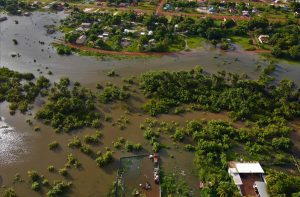–evacuations, relief efforts ongoing
SEVERE flooding across Region Nine (Upper Takutu-Upper Essequibo) has affected over 15,000 persons, according to Chairman of the region’s Regional Democratic Council (RDC), Brian Allicock.
Allicock, during a telephone interview with the Guyana Chronicle on Wednesday, said that the relevant authorities have been monitoring this situation closely and the evacuation of persons has started to intensify.
“Well at the moment about 15,000 people are affected because it’s the entire region actually, from the lower line areas mainly,” Allicock said.
This seasonal flooding is said to occur when water from the Amazon Rainforest in Brazil travels through the Rio Negro River to the Brancho River and, eventually, makes its way to Region Nine.
According to the Regional Chairman, water is still rising in some parts of the region and evacuation exercises are ongoing to remove persons from communities that are severely inundated.
However, at the time of interview, Allicock was still receiving updates from the various community development officers (CDO’s) and as such, was unable to say exactly how many persons were displaced from their homes.

Despite the exact figure not being available at this time, there have been several reports about infrastructure being severely damaged; this includes roads, cassava farms, and farine and bread-making shops. Access roads are still inundated so a complete assessment is unlikely at this time.
“The Moco Moco farmers called in and said that their cassavas are already rotting and the Massara farmers, all them went under water for a week now,” Allicock said adding: “At the moment we are moving out some families from the flooded areas to shelters, and we have to start supplying water and other food items for those in the shelter… then we have to prepare for those who can’t prepare for themselves, so that is where we are at the moment.”
NO LET UP ON COVID-19
Aside from monitoring the situation, Allicock noted that the regional health authorities are also keeping a close watch on COVID-19 in the region, especially since many persons are now being displaced from their homes and placed into shelters.
“We are still monitoring, we are still waiting for CDOs to report and we still have to concentrate on the COVID [19] too because even though we have shelters that can hold 50-60 persons, we have to reduce that number in order to control the spread of the virus,” the Regional Chairman related.
With an improvement in the situation not expected any time soon, Allicock said that persons, who remain in the inundated communities, will need tangible assistance. To this end, regional authorities have started distributing hampers, cleaning supplies and other necessities.
“We just received a lorry load of food hampers from the CDC [Civil Defence Commission] that arrived this [Wednesday] morning from the local government…right now we have to get to the residents, their basic food items, needs and of course sanitary equipment to distribute to the villagers and the municipality,” Allicock said.
So far, the Culvert City Nursery, Arapaima Primary School and Tapachinga Sports Complex have been identified as potential shelters. Residents are being urged to secure all at-risk, personal effects so as to minimise damage to property.
As the battle against mother nature rages on Region Nine, other regions have not been exempted as there have been reports of flooding in Regions Six and 10.
The CDC reported that flooding was recorded in the Canje Creek area of Region Six. Residents of Ikuruwa and Takuba villages along the Canje Creek, are also faced with flooding due to heavy rainfall and the over-topping of the river.
Approximately 30 households from each village were affected; they lost not just household materials, but also livestock and crops.
Assessments were conducted and distributions of 52 hampers were made in Ikuruwa and 107 hampers in Takuba. Residents there are concerned that if the weather persists their losses will increase. Meanwhile, in Region 10, cleaning hampers were distributed in the following areas: Block 42, Rainbow City, West Watooka, First to Third Alley, and Siberian Village. Cleaning hampers were also distributed in Kara Kara, Ladernsville and Kwakwani.
The CDC received reports that Kara Kara, Blueberry Hill, Block 42, Siberian Village and Ladernsville all experienced flooding as a result of heavy and consistent rainfall, and overflowing of nearby creeks and rivers. Approximately 100 households and farmlands of Kara Kara were impacted.
In Blueberry Hill and Block 42, numerous households were affected, and residents there indicated that flood waters will not recede in a timely manner because of improper channels.
At least 20 households were impacted in Siberian Village, but residents and members of the Community Development Council cleaned the clogged drains in the area allowing the water to recede quickly. In Ladernsville, 10 households were affected and residents there indicated that there are insufficient drains to facilitate timely draining of the land.
Persons in need of help can contact the CDC’s National Emergency Monitoring System (NEMS) on 600-7500, 226-1027, and 226-1114 or they can send a message on CDC’s Facebook, Instagram or Twitter accounts.



.jpg)








